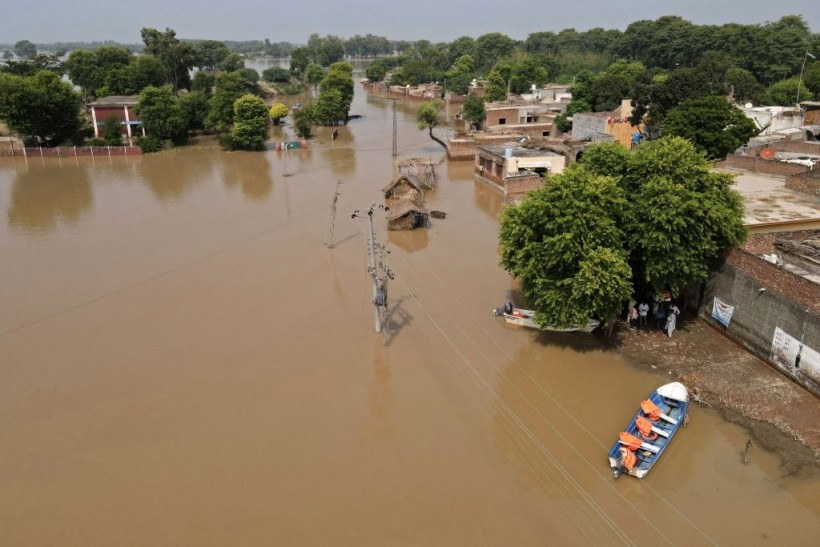The Sutlej River in Pakistan has swelled to extremely dangerous and high levels, prompting the evacuation of more than 100,000 residents.

According to public policy and environment analyst Dawar Butt, an "exceptionally high flood" has been experienced in the area, which he considered as "once in every 30 years."
Butt said that the massive flooding was because Sutlej River had gone kilometers wider in just four days, noting that this has gone even wider than the Indus River.
This is massive flooding — the #Sutlej has gone KMs wider in just 4 days, even wider than the Indus, and much of the border between #Pakistan & #India south of #Lahore division is under water. These flows come from the huge floods caused by Monsoon rains in Northern India. https://t.co/r8AfIGS4tr pic.twitter.com/eJEuJk8VfS
— Dawar B. (@dawarhbutt) August 19, 2023
River swelling
Due to the swelling of the river, much of the border between Pakistan and India as well as the south of Lahore division had been under water.
Butt said the river flows came from the huge inundation that was caused by monsoon rains experienced in Northern India.
The Punjab Irrigation Department said that on August 20, the Sutlej River had flowed at 83,000 cusecs.
The agency warned that all Sahiwal zone teams have been placed on high alert, adding that the entire flood camps on both flanks of Sutlej have been keeping a close watch in the area.
As the river swelling flooded several districts, various rescue operations have been launched to ensure the safety of thousands of residents.
Most of the evacuations that were reported were in the districts of Bahawalpur and Kasur in Punjab province.
8:00 PM at Suleimanki, Sutlej River is flowing at 83,000 cusecs. All Sahiwal zone teams are on high alert, all flood camps on both flanks of Sutlej are keeping a close watch.
— Punjab Irrigation Department (@IrrigationPb) August 19, 2023
Video: Courtesy Chief Engineer Sahiwal pic.twitter.com/RqHQom5GVA
The United Nations Office for the Coordination of Humanitarian Affairs (OCHA) - Pakistan disclosed that more than 238,000 individuals and 17,000 livestock have been evacuated as seven districts were affected in the swelling of the Sutlej River.
The deep floods then submerged farmland and crops.
Officials also said the water levels in the Ravi river are currently normal, but it is expected to further rise in the Sutlej river this week.
Punjab Floods:
— OCHA Pakistan (@OCHAPakistan) August 22, 2023
Flooding in the Sutlej River affected seven districts: Kasur, Okara, Bahawalpur, Pakpathan, Vehari, Bahawalnagar, and Lodhra.
According to NDMA,
Over 238,000 people and 17,000 livestock have been evacuated, & farmland and crops have been submerged.#PunjabFloods pic.twitter.com/e18ozgaxtg
Read Also: Pakistan Flood Death Toll Reaches 1000 as Government Declares Climate Catastrophe
Previous floods
Meanwhile, the OCHA also provided an assessment as regards the floods that hit Chitral in the later part of July this year. The massive floods had a profound impact on people's lives and livelihoods.
Authorities said that the districts of Lower and Upper Chitral had received an exceptional and unprecedented torrential or orographic rain.
These rains were followed by thunderstorms, cloud outbursts, and flash floods in the streams that later resulted in massive devastation.
"These floods exposed Chitral's vulnerability to climate change, underlining the urgent need for immediate humanitarian response coupled with disaster risk reduction and resilience-building efforts," OCHA said.
Further, the inundation brought extensive damage to infrastructure, housing, education, transport, communications, water resources, agriculture, fisheries, and protective structures.
To recall, it was in 2022 when Pakistan was also hit by monsoon rains which caused floods that affected millions of people.
The OCHA said that the unrelenting monsoon rains across Pakistan was considered as the "worst in a decade," as it resulted in widespread flooding and landslides between June and August 2022.
The flash floods killed more than 1,700 people, destroyed 2.9 million homes, and left 20.6 million people in need of assistance.
The inundation also caused significant damaged in the infrastructure, affected 33 million people as it displaced 7.9 million individuals.
It also had an adverse effect on agriculture, flooding 9.4 million acres of crops and killing more than 1.1 million livestock.
The Center for Disaster Philanthropy said that the 2023 monsoon season could slow the recovery from the 2022 floods and bring additional hardship for Pakistan.
It noted that as of August 5, the monsoon season this year resulted in the deaths of 196 people and injury of 283 others across seven provinces.
Related Article: Devastating Flood in Pakistan Reveals the Linkage to Climate Change
Related Video:
© 2024 NatureWorldNews.com All rights reserved. Do not reproduce without permission.


![Climate Change is Reducing Dust Levels Worldwide as Arctic Temperature Warms [Study]](https://1471793142.rsc.cdn77.org/data/thumbs/full/70320/280/157/50/40/climate-change-is-reducing-dust-levels-worldwide-as-arctic-temperature-warms-study.jpg)


